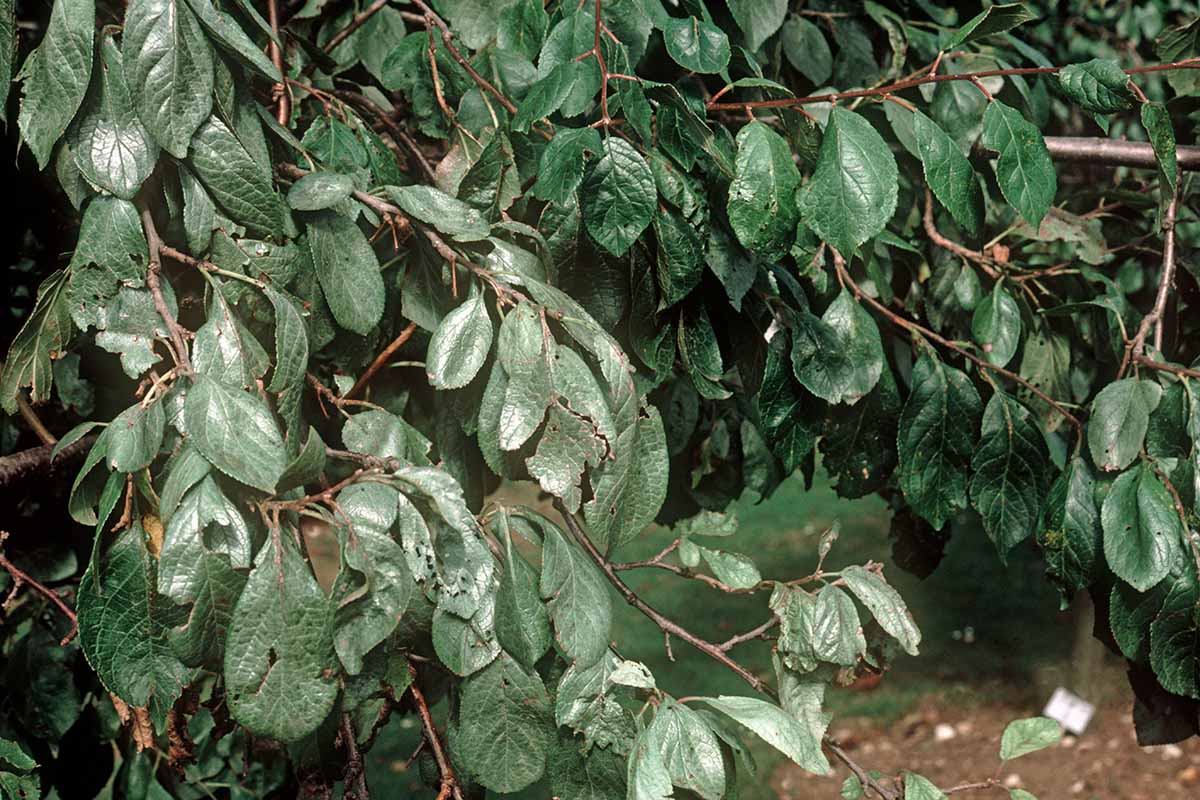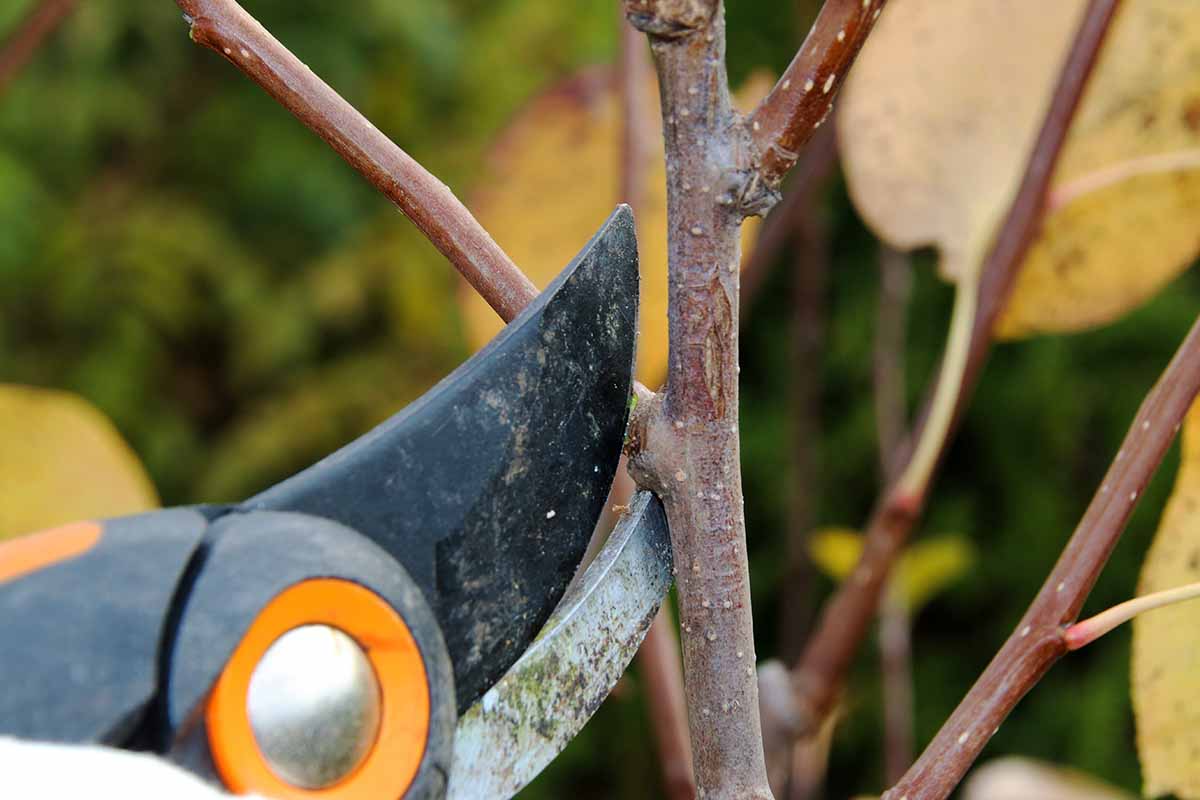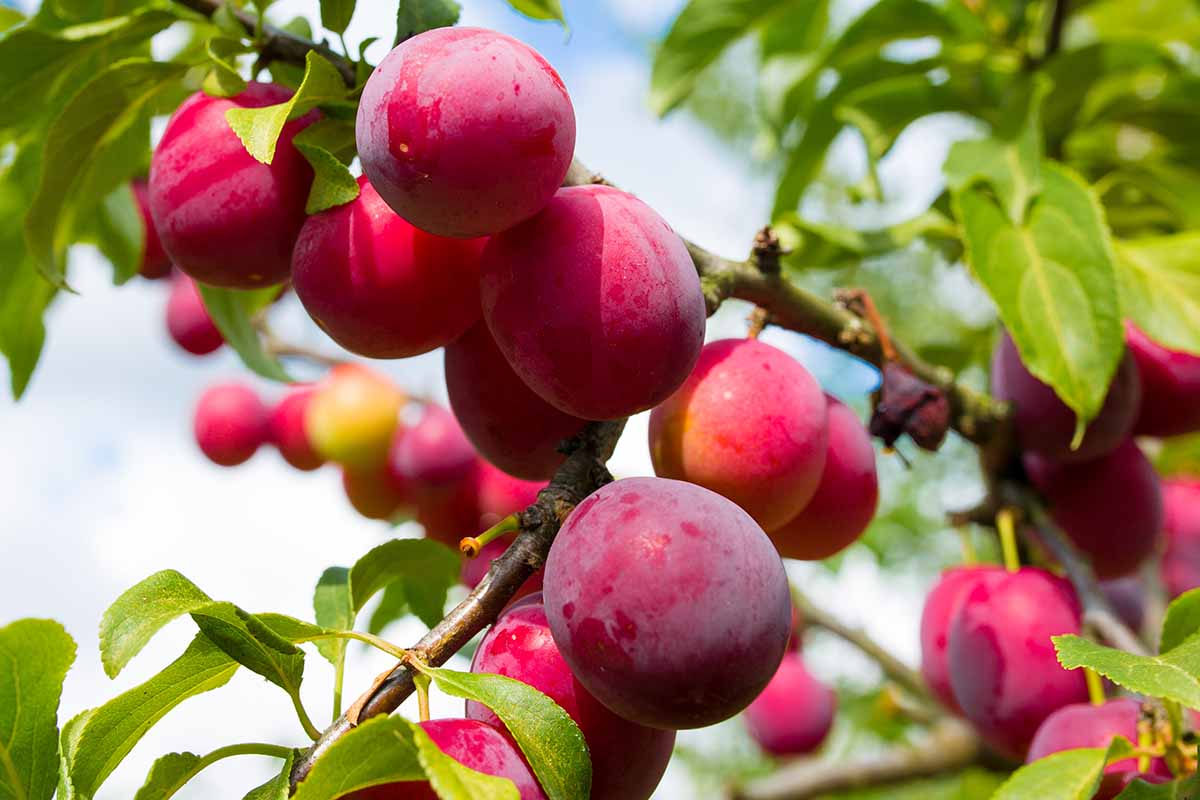If you’re new to fruit tree growing and pruning, you absolutely can’t go wrong with plums.
Some trees will stop producing well unless you give them the proper chop. But prunes will keep on chugging despite your neglect.
Of course, they’ll do much better if you treat them right, and that includes regular, strategic pruning.

We link to vendors to help you find relevant products. If you buy from one of our links, we may earn a commission.
The real challenge with pruning plums is in the timing. It’s not hyperbole to say that pruning at the wrong time can kill your tree.
That might sound dramatic, but there’s a disease out there that attacks plums if you prune them at the wrong time of year.
Don’t worry, we’ll help you figure out when to start the work and everything else you need to know. Here’s what’s coming up in this guide:
What You’ll Learn
There are two different stages of pruning. The first is establishing the ideal shape and the second is yearly maintenance.
Once a tree has been shaped, it’s your job to maintain it. This primarily involves removing dead, diseased, and deformed wood.
It’s not just about shaping and removing bad wood each year, though. This also helps the plant to stay productive.
Plums flower and fruit on either older wood or year-old wood, depending on the species.
When to Prune Plums
Generally, we prune plums in the summer or winter. That’s because these trees are extremely susceptible to a disease called silver leaf.

If you prune in the spring or fall, you run the risk of infecting your trees with the fungus that causes this disease, Chondrostereum purpureum.
The fungus thrives in the wet weather of fall and spring, and that’s when this disease spreads. Open wounds provide an opportunity to attack.
It can live on numerous species in the ornamental garden, including maples, hawthorns, willows, lilacs, cherries, apples, and pears. But plums are the most susceptible.
When the disease is present, the leaves take on a silvery sheen that is awfully pretty, but it’s a sign of bad news. There’s no known cure for it, and it can spread like wildfire in the orchard.
When you do prune, do it during a period of dry weather. Conditions should be dry for at least a week before pruning and predicted to be dry for a week after. The longer the weather remains dry, the better.
Don’t feel like you have to wait for summer or winter – your local conditions are what matter most.
If you regularly have a dry stretch in fall or spring, go ahead and do your pruning then.
Dry weather is more important than the time of year. You can even do part of the work in the summer and a bit more again in the winter.
Overgrown specimens should be shaped back up over a series of years.
Of course, if you see diseased or broken limbs, these should be pruned right away. Pruning diseased parts regularly is the first step to preventing diseases from decimating your trees.
There’s some evidence that the fungicide furmecyclox can help prevent the disease when applied to the pruning wounds, but since that’s not available to the home gardener, we have to stick to managing our timing.
The sap that trees exude after being cut actually provides natural protection, so don’t apply a wound sealant.
Gather Your Tools
You don’t need anything special to keep your trees in tip-top shape. The usual tools apply here.
- Shears or secateurs
- Loppers
- A tree saw
- A ladder
You need something to take off the large limbs and something for the smaller growth.

You will probably also need something to help you reach those taller branches, like a tree saw or a ladder.
Know Your Terms
Before we jump in, let’s make sure we’re all on the same page.
The trunk is, of course, the mail central support. From there emerge the limbs or branches. These are the scaffolding of your tree and we won’t trim this portion.
Vase-shaped trees have about five limbs. Central leader shapes can have about the same number, or sometimes a few more. These are usually at least three feet above the ground.
In addition to the main limbs, a tree will have side branches, which are sometimes called laterals.
These are the twigs, shoots, and smaller branches. These side branches might have smaller branches growing from them as well.
Most of the fruit is formed on what are called spurs. A fruit spur is a short growth that grows at about a 45-degree angle from the branch.
These spurs typically grow on year-old or two- to three-year-old branches.
Trees will also have leaf and flower buds, but we don’t really have to worry about these since they’re not relevant to the pruning process.
Pruning Young Trees
Young trees require special pruning to set them up for success.
If you purchase a tree that is over three years old – and most are – it is probably already pruned to the appropriate shape, and all you need to do is maintain it.
Pruning a tree when it’s young gives you a shape that is not only more productive, thanks to better light exposure and air circulation, but it is also easier to prune in the future.
You also want a structure that can bear the weight of the fruit.
For common plums (Prunus domestica), if you have a tree that’s under a year old, trim the main stem to about three to four feet tall, so long as there are about five or six spurs below where you trim it.

Make the cut just above a spur. Remove any side shoots by cutting them right at the ground.
The year after planting, the young tree will send out new shoots below the cut. The one nearest to the top that grows straight up will become the central leader.
Leave it in place. If it’s growing a bit crooked, use growing tape or clothespins to hold it upright.
Allow the lower branches to develop over the course of the year. The following year, remove all but four or five of the limbs.
You’re looking to keep branches that make a 45-degree angle with the main stem. These will be the strongest.
The next year, prune to include another four or five main branches, so that you have up to 10 total.
Japanese or Chinese plums (Prunus salicina) need to be pruned into a vase shape. To do this, find a group of four or five spurs about two or three feet above the base.
Make a 45-degree cut right above each spur, sloping away from the spur.
The buds below the pruning cut will grow outwards, creating what we call a vase shape. Prune off any lower branches below the top four or five as they emerge, as well as any competing branches that try to grow within the “vase.”
For both types of plums, this initial shape should be maintained for the first few years. At about five years, you can start pruning according to the methods outlined below.
Pruning Japanese Plums
Japanese plums flower and fruit on year-old wood, and they’re much more vigorous than the common species.
That means we need to prune to preserve young wood without overloading the tree, or you won’t be getting much fruit.
Cut off any that grow below the main limbs of the vase. Next, cut off any crossing or deformed limbs.

The branches best able to support fruit are called scaffolding branches. These are the ones that grow about 45 degrees in relation to the trunk.
Those that have a narrower or wider crotch tend to crack when laden with fruit. Aim to leave as many of these scaffolding branches in place as possible.
Now you want to go in and encourage new growth, since that’s where the fruit will develop. Look for the longer branches.
Cut them back in front of a fruiting spur, leaving about a dozen spurs on the branch. This will encourage a new section to grow with new fruiting spurs.
If a branch is a bit short, under a foot long, don’t trim it back. Let it grow some more length first.
Finally, trim off any water sprouts and thin out the branches, concentrating on older laterals, so you’re left with about half of the growth that you started with.
You want to do this so there aren’t too many limbs producing fruit and overloading the tree.
Now you should have the right balance of productive wood while creating an open vase shape that allows for good air circulation and access for harvesting.
Larger branches should be cut with the one-two-three method.
This involves first cutting a branch from the bottom about halfway through at a point several inches out from the trunk. Then cut off the length of the branch coming from the top down just an inch or two out from the undercut.
Finally, cut the remaining stump off at the collar. You don’t want to make the cut flush with the trunk.
You should start the cut at the crotch of the branch and trunk and then cut down and out at about a 45-degree angle. Don’t leave a stub of the branch in place, since this can introduce disease.
Smaller branches should be clipped flush with the main branch.
Pruning Common Plums
Common or European plums (Prunus domestica) fruit on wood that is two years old or older.
Branches that are 10 or 20 years old might taper off in production as they age. When shaping up these trees, give them a central leader shape.
Again, you want to retain those growing at about a 45-degree angle from the trunk.
The first step is to remove any dead, diseased, dying, or deformed wood (we call these the four “Ds”).
When we say “deformed,” we’re talking about branches that cross or rub against each other, or that are bent or growing in rather than out.
Next, prune the new, young whip shoots back by about half to encourage branching. Cut in front of a fruit spur.
Now, you can thin the tree out a bit. Just keep in mind that these trees fruit best on young wood. Don’t prune off wood that is under three years old. Target older wood instead.
There are a few common plums that grow horizontal branches. ‘Victoria’ is one such cultivar. For these, just focus on thinning and not so much on choosing branches with the perfect 45-degree shape.
To help the branch balance itself so it won’t break when laden with fruit, prune just above an upward-facing shoot.
Use the cutting guidelines described above to make the cuts.
Fruit Thinning
Plums tend to produce a larger crop one year and then a smaller crop the next.
In those big years, the trees can be a bit over-enthusiastic. The best way to help the tree out is to thin the fruit a little.
This should be done twice a year when the developing fruit is present.

The first time is when the fruits are young and immature, usually around May. Look the tree over and pluck off some of the fruits if a branch looks overladen.
Basically, you’re looking for fruits that touch each other or look like they might in the future. Take up to half of them off the branch.
The second round is done later, as the fruits are nearing maturity.
Look the plums over and remove any damaged or diseased fruits and any that exhibit signs of pest damage.
Prune Those Prunes… er, Plums
Plums don’t ask for much and they give so much in return. A single tree gives you enough fruits for all of your jam, pie, kuchen, and cobbler needs.
Even neglected trees will offer up handfuls of fruit.

But we don’t want handfuls, we want enough fruit to fill buckets and buckets! Pruning can help to make that happen.
Have you run into any problems pruning your trees? Need a little guidance? Tell us what you’re experiencing in the comments, and we’ll see if we can help.
Keep going with that orchard of yours. If you’re wondering about how to maintain fruit trees in other ways, our guides can shed some light on the subject. Give the following a read next:
We do not have a pruning issue but a serious issue with the fruit. Maybe some kind of blight. We have tons and tons of plums but we don’t end up with very many because they start turning like a jelly like substance with it oozing out of the plum. If left long enough it basically then turns into a prune and all dries up. Seemed to have jumped to other fruit trees as well like peach and cherry. Doesn’t seem to affect apples or another plum tree that has yellow plums. It’s the plums pictures in your article that… Read more »
Hi Tammy, it sounds like you might be facing brown rot. Brown rot is caused by a fungus (Monolinia fructicola and M. laxa) and causes the symptoms you describe. It can attack any stone fruit, like peaches, cherries, plums, and apricots. Now is the time when it really starts to show, and in addition to what you described, you’ll also see brown fungal spores on the outside of the fruit before it dries up. It will take a year or two to eliminate the problem since it has already taken hold. First, you can spray your trees with sulfur about… Read more »
Three years ago I planted two 2’-3’ B&B Prunus maritima (Beach plums) in the informal foundation landscape of a small office building and am ready to give them their first proper pruning.
Since they serve ornamental purposes rather than for fruit production, should I still follow the pruning practices described in your article?
I’m tempted to let them grow wild but is this wise? And what time of year should this surgery be performed ?
Hi Sean, peach plums don’t need to be pruned in the same way if you aren’t interested in the fruit. Instead, pruning should mostly be about providing the shrubs with a nice shape. Prune any branches that are touching the ground and take out anything that is dead, damaged, diseased, or ugly. Other than that, you can let them do their thing.
You can prune a branch here and there if needed at any time of year, but serious pruning should be done in the late winter or early spring when the shrub is dormant.
Hi. We acquired an Italian plum tree when we bought home 6 years ago. It did really well for few years. Last year, we didn’t notice until too late, but was infested with aphids. We sprayed and trimmed. This year, no fruit and hardly any leaves. Wondering if it died? Should I still be trimming dead branches? I tried fertilizing in the spring, but nothing.
Not sure what I should do at this point.
Hi Rhonna, fruit trees develop fruit based on the resources from the previous growing year. That means that since your tree had what sounds like a serious aphid infestation, it didn’t have enough resources to produce good fruit this year. So long as you care for the tree and remove any branches that you’re sure are dead, it should return to good form next year or the following year.
Hi Kristine, My husband and I recently purchased a house in the PNW appears to have been a rental unit prior to our purchase. That is to say that the backyard has been thoroughly neglected and ignored. In the back corner of our lot is a giant prune plum tree that has grown out of control, with all of the fruits growing far out of reach. It’s a fairly well established tree, with a trunk about 12″ diameter (though it’s hard to get in there and accurately measure it with all the overgrowth). I’m in this for the long haul,… Read more »
Hi Charlotte, I’m in the same boat as you! I just bought a house outside of Portland and the fruit trees have been badly neglected. I’m wrestling several plum trees back into shape. Plan on taking three years to do this. You don’t want to remove more than a third of the growth in one year. The first cuts you should make is to remove anything that is diseased, damaged, or deformed (the three Ds). Then, take off any branches that rub or cross each other. Now you can work on shape. Remove anything that is prohibiting you from accessing… Read more »
new growth long straight branches about 5 feet tall can you trim them. now.
Hi Irene, these sound like water sprouts and they should be removed. If the weather is dry and will continue to be for a week or so, feel free to remove them right now.
Good morning
I have a 4/5 year old Italian plum tree in a large planter on my deck. So do I need another tree to make fruit? It’s on my deck to protect it from deer. Portland Oregon
Hi Cheryl, it depends on the cultivar that you have. Some are at least partially self-fruitful. Here in Portland, we have a lot of plum trees, so if a neighbor nearby has one, you might get away with having a self-infertile tree by itself. Otherwise, yes, you probably need a companion.
I was wondering if you have pictures to show each step of pruning. Here’s what i did to mine does it look correct?